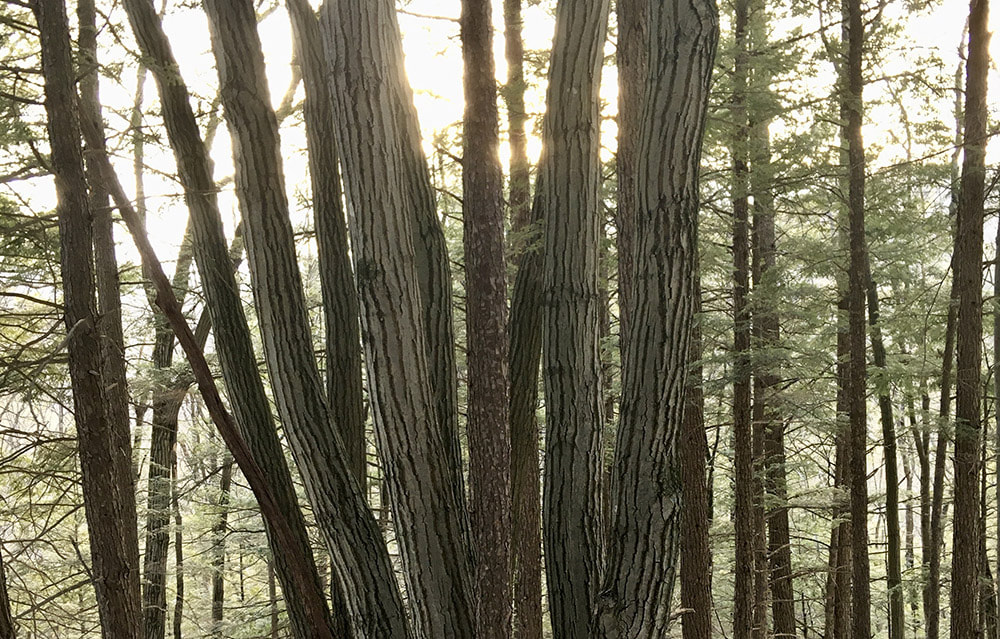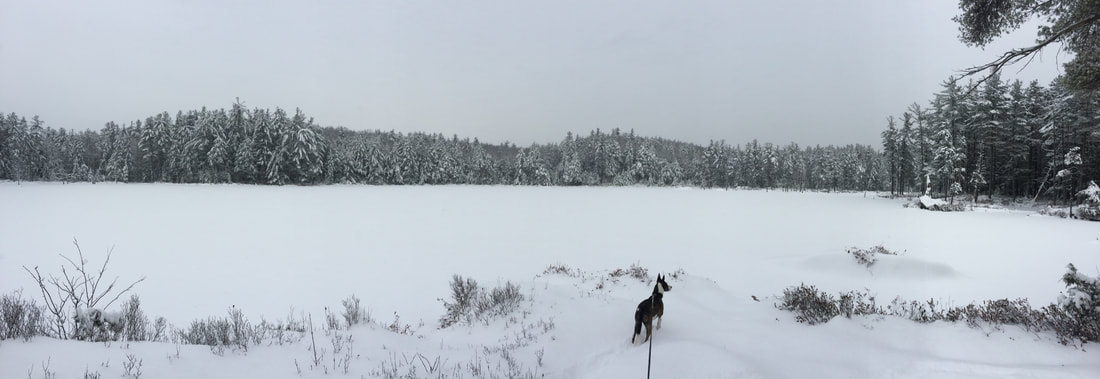 Progress Cycles 2023 Tapestry 23” x 32” Homegrown, hand processed and handspun flax>linen warp; handspun gifted Vermont wool; studio-grown indigo, locally foraged black walnut and dyer’s polypore natural dyes; handmade pottery buttons by the artist’s father; NASA service pins belonging to the artist’s paternal grandfather This body of work that I’m calling Landcestors grew out of the natural fiber and dye materials that I’ve been growing, processing and creatively collaborating with for several years. Being in intimate conversation with the land through these materials inspired me to explore the possibilities of intertwining human and land stories and forms. I started with the premise that the earth is made of the same elements as the human body and experiences change and trauma as do people. Loosely using the body form as landscape, map and timeline, these pieces bear witness to the confusing nature of trauma, on both bodies and land, while simultaneously suggesting the regenerational possibilities available in the body and in the land. My vision is that the generous natural materials of Landcestors, being so close to their origins in the land, can lend themselves to reconciling and integrating the shards and twisted narratives of personal and cultural histories in ways that evoke wholeness.
Two of these torso-shaped tapestries hold elements of my personal ancestral stories, conceived as landscapes. One tapestry imagines the emergent nature of the earth in human form. And one tapestry considers the landscapes we hold inside our earthy, watery bodies. The creation of these works was supported by the Vermont Arts Council.
3 Comments
Springtime in the northern woods is amazing. I hope a lot more folks are getting to enjoy it as the world slows down and we try to stay distanced. In Vermont, the spring ephemeral wildflowers are simple joy embodied, along with birdsong, glowing green moss and hints of tree leaves popping out. This is also the best time of year to forage windfallen lichens for dyeing, after winter storms and ice have dislodged many from the surfaces they cling to. As I go on long wanders in my surrounding woods, I’ve been picking up bits of Parmelia sulcata and Hypogymnia physodes to mix together in a dyebath. These “boiling water lichens” or “crottles” in their Scottish vernacular, dye lovely rusty browns and golden oranges when extracted with simmering water, but you need a very high ratio of lichen to fiber to get the richest colors. I haven’t used them much because of the difficulty of sustainably gathering the quantities needed to dye enough yarn for a project.
I want to share an exercise that I used to start off the foraging part of my workshop in August. In thinking about what would be valuable for students to take away with them, I reflected on the things that foraging and growing natural dyes has taught me beyond the practical steps to transferring color to fiber, such as: new modes of being in the ecosystems around me, a way working with the sensitivity I have always felt towards non-human forms of life, and an intention to remain open to the possibilities of learning from the organisms that provide my dyes. These lessons mirror and support a whole philosophy of living slow, observing deeply, and exploring not just a creative practice, but an ethical and socially engaged life as well.
This Christmas finds me thinking deeply about gifts. Not the wrapped items under the tree so much as a philosophy built on a virtuous circle of generosity. And a system called the Gift Economy, which acts on an entirely different axis than our capitalist economy. Thwarted by a snow storm from visiting family today, my dog and I opted for a long snowshoe up the ridge behind my house to the Lily Pond. It’s a familiar tromp for me and it was fun to say hi to the spots where I picked dye mushrooms just a few months ago now all blanketed in white. When I collect wild stuff for dyes, I don’t pay for it. But I do pay attention to what I am doing, acknowledge the joy of discovery, take a moment to study the living plant or mushroom before I pick it, and make sure to never take more than would be sustainable for a particular patch. When I started foraging a few years ago, I could sense first-hand what it felt like to be greedy with Nature’s gifts. The usually enjoyable activity of walking in the woods felt icky if I was trying to load up on and possess these scarce and beautiful beings that were sitting so perfectly in their home environments. I’ve been reading Robin Wall Kimmerer’s Braiding Sweetgrass which has given not only validation to my practice of paying attention to how I forage, but a framework for reciprocity with the land based on the concept of the gift economy. By taking the time to have a relationship with the wildflower and mushroom patches year after year, I learn their habits, can watch when and where they appear, if they seem stressed or vigorous, and only if there is a bounty do I read it as being a gift for me to gather. In turn, I do what I can to protect and enhance their environments and I spread their spores and seeds through the slats of my baskets. They should flourish more and more through the attention and respect I offer. I don’t need huge quantities of any of these precious dye bearing bodies to make the quantities of hats that I do, and I let what is plentiful dictate what colors will populate the patterns.
|
AuthorHannah Regier Archives
May 2023
Categories
All
|




 RSS Feed
RSS Feed